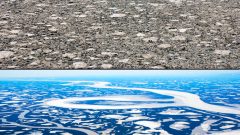Canadian research reveals new clue to rapid Arctic ice melt

Photo Credit: M. Milne/Northwest Territories Government/The Canadian Press)
A new study of the Arctic’s vast Mackenzie river delta has discovered that an unexpected aspect of climate change is having a very big effect.
Lance Lesack, a professor in both the Department of Geography and Department of Biological Sciences at Simon Fraser University in British Columbia.
While the study was looking at a specific phenomenon regarding an earlier break-up of ice jams in the Mackenzie delta, the discovery may help to explain why Arctic sea-ice is melting so fast.
Professor Lesack is the lead author on a report called “Local spring warming drives earlier river-ice breakup in a large Arctic delta”, along with co-authors from Wilfrid Laurier University in Ontario, the University of Alberta, and Memorial University in Newfoundland

- The upper image is an aerial view of an ice jam in Middle Channel in the central Mackenzie River Delta during the annual ice-breakup period. The lower image shows the intact ice sheet in Middle Channel one day prior to the initiation of breakup and dynamic ice jamming that filled the channel with large-scale ice rubble, as shown in the upper image. The lower image is also a wider scale view of Middle Channel that shows the off-channel lake-richness of this ecosystem. The Mackenzie Delta covers an area ~13,000 km2, contains 45,000 lakes, and warmer springs combined with reduced winter snowfall may be changing the ice breakup regime that drives peak annual water-levels and thereby sustains these lakes (both images are south-looking and were taken in late May 2008 during International Polar Year investigations (L Lesack)
The vast Mackenzie delta at the end of Canada’s longest river, covers some 13,000 sq.km and extends some 200km inland. When spring arrives, the ice along this huge river and tributaries begins to break up, flow downstream and eventually jams in the delta. In turn the resultant flooding helps to replenish tens of thousands of lakes, ponds and wetlands in the region.
The jams historically occur at almost the exact same time each year, and eventually break-up at almost the same time. However in recent years, while the jamming is still relatively consistent, the ice is breaking up and clearing the delta much sooner than before.
The hypothesis was that it was simply warmer, and/or that due to warming there was more precipitation creating greater flow ie pressure- in the river to break up the jams.
Normally with global warming there is more moisture in the air, and more precipitation which increases flow in rivers. This is the case for Russian Arctic rivers, but the researchers somewhat to their surprise, found that flows in the Mackenzie seemed to be stable.
In studying this further, the researchers found something different.
It was certainly warmer, over 5 degrees Celsius on average during the winter, but that didn’t seem to have any great affect on ice breakup.
They also found a little over 3 degrees C average warmer temperatures in spring, but that this did have a huge affect on the breakup, but however, did not by itself explain the rapid melting.
Lessening snow depth plays an important role in ice melt
After further study they found what seemed to be the key. They discovered that in recent years there was less snow cover by spring.
This allowed solar more solar radiation through to the ice, and along with the slightly warmer spring air, resulted in the ice jams melting and breaking up faster, and clearing out, within just 27 days instead of the historically typical 35 days.
Professor Lesack says this is the first field-based study to uncover an important effect of reduced winter snowfall and warmer springs in the Arctic — earlier-than-expected, climate-change-related ice breakup.
“The polar regions have a disproportionate effect on planetary reflectivity because so much of these regions consist of ice and snow,” says Lesack. “Most of the planetary sea ice is in the Arctic and the Arctic landmass is also seasonally covered by extensive snow. If such ice and snow change significantly, this will affect the global climate system and would be something to worry about.”
Related Links:
Lance Lesack Video presentation on world importance of Mackenzie Basin



